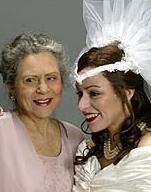SITE GUIDE
SEARCH
REVIEWS
REVIEW ARCHIVES
ADVERTISING AT CURTAINUP
FEATURES
NEWS
Etcetera and
Short Term Listings
LISTINGS
Broadway
Off-Broadway
NYC Restaurants
BOOKS and CDs
OTHER PLACES
Berkshires
London
California
New Jersey
DC
Philadelphia
Elsewhere
QUOTES
TKTS
PLAYWRIGHTS' ALBUMS
LETTERS TO EDITOR
FILM
LINKS
MISCELLANEOUS
Free Updates
Masthead
Writing for Us
A CurtainUp Review
From Door to Door
By Elyse Sommer
|
How do I know what I want--it's been so long since anyone asked me. --- Mary, whose devotion to her family has convinced her daughter that she should receive a "Nobel Prize for nurturing." |

Anita Keal and Sarah McCafrey
|
The trajectory of the three generations of one family's women -- the title is a translation of a Hebrew prayer, "l'dor v'dor" or "from generation to generation" -- from impoverished immigrants to assimilated but still connected to their roots Americans could be any nationality, and take place in New York or Boston as easily as Chicago. For every Yiddish truism uttered by Bessie (Anita Keal), the Door to Door matriarch, there's sure to be an Italian, Irish, Chinese or other goyish counterpart.
The play opens up with Mary (Suzanne Toren) sitting in a room bare except for a chair. She is sitting shiva (the Jewish ritual of mourning) for her husband. This lonely and downcast woman represents the middle layer in the generational sandwich. She's the first generation American who followed her mother's dictum that women belonged in the home but wants her daughter to be like Betty Friedan and Gloria Steinem.
The opening turns out to be a lead-in to a lengthy flashback taking us back to the opening scene. While the story goes all the way back to the East European shtetl from which Bessie escaped to America, the action begins when Mary is a senior in high school. Mother and daughter differ vastly in their dreams for a good life. Mary dreams of studying to become an artist but practical Mama dismisses dreams because" they don't pay the rent". And so the battle lines are drawn, but for all their differences and Mary's chafing at being the family's nurturing rock of Gibraltar -- helping her husband in his business, caring for their home, children and, eventually the aging Bessie -- she loves them all.
Considering that the play stretches over such a long time span and its numerous sociological issues, Door to Door is more serious and ambitious than Beau Jest. Nevertheless, Sherman is not above using every cliche in the book of Jewish stereotypes to build his triumvirate of daughters and mothers nudging each other towards a predictably fuzzy warm finale. Some of the shtik he writes for Bessie is almost unbearably trite; notably, the way she bullies Mary into abandoning her ambitions and the slap on the newly pregnant Mary's cheeks ("You're going to be a mother so you have to get used to pain"). Given Bessie's characterization as the epitome of everyone's vision of a bossy and superstitious Jewish mother you've got to admire Sherman's chutzpah in the way he uses the presentation of the progroms in Fiddler On The Roof to reveal Bessie's painful and heretofore undiscussed exodus from Europe.
Strangely the off-putting cliches also manage to be strengths. Somehow, Mr. Sherman and the actresses portraying these women surprise us by eventually overcoming their stock characteristics and becoming flesh and blood individuals whom we cherish like chicken soup and matzoh balls. If those revelations about Bessie and Mary's love lives are a bit saccharine, it's fun to believe that these often sour ladies did have some good times. And if Sarah McCafrey's Deborah is almost too good to be true, she does rouse every mother's hope (including this one) that, unlikely as it seems, maybe one day her daughter will tell her "you deserve a Nobel Prize for nurturing."
Joe Brancato directs the shifts from present to past and forward with a firm but unobtrusive hand. Tony Straiges' semi-abstract set creates a nice sense of the moves to different neighborhoods and from one life stage to another. Ingrid Maurer's costumes help to establish the march of time -- with the biggest fashion leap made by Bessie when she appears in an elegant rose-colored outfit for her granddaughter's wedding.
With two weddings, two funerals, and its comforting familiarity, it may well follow in the footsteps of a previous West Side Arts tenant, Vagina Monologues -- becoming something of a girls' night out. If they serve samples of that gefuellte fish being chopped in Bessie's kitchen, maybe it would induce their husbands and boyfriends to come along.
| From Door to Door
Written by James Sherman Directed by Joe Brancato Cast: Anita Keal, Suzanne Toren, Sarah McCaffre Set Design: Tony Straiges Costume Design: Ingrid Maurer Lighting Design: Jeff Nellis Sound Design: Johanna Doty Running time: 1 hour and 30 minutes with no intermission Westside Theatre Downstairs, 407 West 43rd Street ( 9th / 10th Avenues) 212/239-6200 From 3/16/04 to 5/02/04; opening 3/24/04. Tuesday - Saturday @8pm, Wednesday & Saturday @2:30pm, Sunday @3pm -- $55. Reviewed by Elyse Sommer based on March 23rd press performance Closed 6/27/04 |

Mendes at the Donmar
Our Review

At This Theater

Leonard Maltin's 2003 Movie and Video Guide

Ridiculous!The Theatrical Life & Times of Charles Ludlam

Somewhere For Me, a Biography of Richard Rodgers

The New York Times Book of Broadway: On the Aisle for the Unforgettable Plays of the Last Century

6, 500 Comparative Phrases including 800 Shakespearean Metaphors by CurtainUp's editor.
Click image to buy.
Go here for details and larger image.



